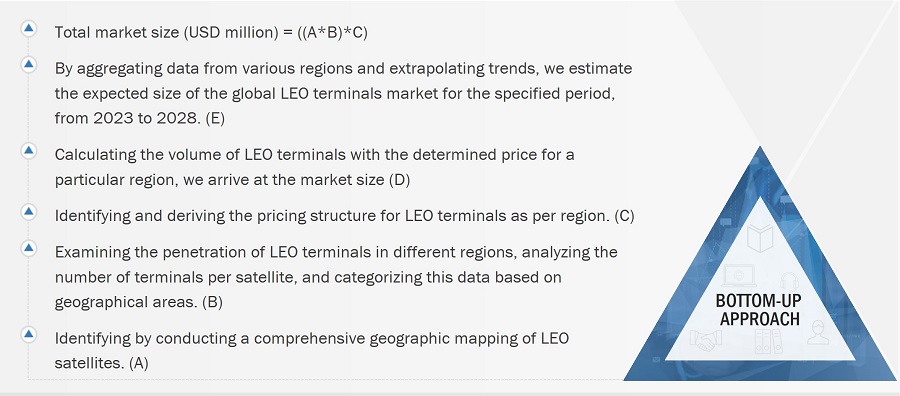The research study conducted on the LEO terminals markets involved extensive use of secondary sources, directories, and databases such as Hoovers, Bloomberg Businessweek, ITC Trade data and Factiva to identify and collect information relevant to the LEO terminals markets.
The primary sources considered included industry experts from the LEO terminals markets as well as sub-component manufacturers, LEO terminals raw material suppliers, government agencies, technology vendors, system integrators, research organizations, and original equipment manufacturers related to all segments of the value chain of this industry. In-depth interviews with various primary respondents, including key industry participants, Subject Matter Experts (SMEs), industry consultants, and C-level executives, have been conducted to obtain and verify critical qualitative and quantitative information pertaining to the LEO terminals markets as well as to assess the growth prospects of the market. Sources from the supply side included various industry experts, such as chief X officers (CXOs), vice presidents (VPs), and directors from business development, marketing, and product development/innovation teams; related key executives; independent consultants; importers; and key opinion leaders.
Secondary Research
The market ranking of companies was determined using the secondary data made available through paid and unpaid sources and by analyzing the product portfolios of major companies. These companies were rated on the basis of performance and quality of their products. These data points were further validated by primary sources.
Secondary sources referred to for this research study include financial statements of companies offering LEO terminals and information from various trade, business, and professional associations. The secondary data was collected and analyzed to arrive at the overall size of the LEO terminals market, which was validated by primary respondents.
Primary Research
Primary interviews were conducted to gather insights such as market statistics, data of revenue collected from the products and services, market breakdowns, market size estimations, market forecasting, and data triangulation. Primary research also helped in understanding the various trends related to technology, threat type, range, domain, and region. Stakeholders from the demand side, such as CIOs, CTOs, and CSOs, and installation teams of the customer/end users who are using anti-aircraft systems were interviewed to understand the buyer’s perspective on the suppliers, products, component providers, and their current usage of anti-aircraft systems and future outlook of their business which will affect the overall market.

To know about the assumptions considered for the study, download the pdf brochure
Market Size Estimation
-
The top-down and bottom-up approaches were used to estimate and validate the size of the LEO terminals markets. The research methodology used to estimate the market size also included the following details.
-
The key players were identified through secondary research, and their market ranking was determined through primary and secondary research. This included a study of the annual and financial reports of the top market players and extensive interviews of leaders, including chief executive officers (CEO), directors, and marketing executives.
-
All percentage shares, splits, and breakdowns were determined using secondary sources and verified through primary sources. All possible parameters that affect the markets covered in this research study were accounted for, viewed in extensive detail, verified through primary research, and analyzed to obtain the final quantitative and qualitative data. This data was consolidated, enhanced with detailed inputs, analyzed by representatives in MarketsandMarkets, and presented in this report.
Market size estimation methodology: Bottom-up Approach

Market size estimation methodology: Top-Down Approach

Data triangulation
After arriving at the overall size from the market size estimation process explained above, the total market was split into several segments and subsegments. The data triangulation and market breakdown procedures explained below were implemented, wherever applicable, to complete the overall market engineering process and arrive at the exact statistics for various market segments and subsegments.
Market Definition
LEO terminal is a system integrated into commercial and military platforms to enable satellite-based communications applications. These terminals are engineered to facilitate the seamless transmission and reception of signals between LEO satellite networks and terrestrial stations. These terminals are prime in establishing dependable and efficient communication links, empowering a range of applications, including high-speed internet access, voice communication, data transfer, video broadcasting, remote sensing, and IoT connectivity.
Stakeholders
-
Military Antenna Manufacturers
-
System Integrators
-
Original Equipment Manufacturers
-
Military Service Providers
-
Research Organizations
-
Investors and Venture Capitalists
-
Ministries of Defense
-
R&D Companies
Report Objectives
-
To define, describe, and forecast the size of the LEO terminals market based on platform, vertical, frequency, and region in terms of value
-
To forecast the size of market segments across North America, Europe, Asia Pacific, the Middle East & Africa, and Latin America, along with key countries in these regions
-
To identify and analyze key drivers, restraints, opportunities, and challenges influencing market growth
-
To identify industry trends, market trends, and technology trends prevailing in the market
-
To analyze micromarkets1 with respect to individual technological trends, prospects, and their contribution to the market
-
To strategically profile key market players and comprehensively analyze their market rank analysis and core competencies2
-
To identify the detailed financial positions, product portfolios, and key developments of leading companies in the market
-
To provide details regarding the competitive landscape of the market and analyze growth strategies such as product launches and developments, contracts, partnerships, agreements, and collaborations adopted by key market players
1Micromarkets are referred to as the segments and subsegments of the LEO terminals markets considered in the scope of the report.
2Core competencies of companies were captured in terms of their key developments and key strategies adopted to sustain their positions in the market.
Available customizations
Along with the market data, MarketsandMarkets offers customizations as per the specific needs of companies. The following customization options are available for the report:
Product Analysis
-
Product matrix, which gives a detailed comparison of the product portfolio of each company
Regional Analysis
-
Further breakdown of the market segments at country-level
Company Information
-
Detailed analysis and profiling of additional market players (up to 5)



Growth opportunities and latent adjacency in LEO Terminals Market